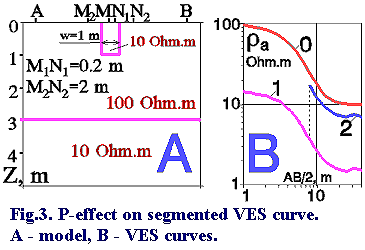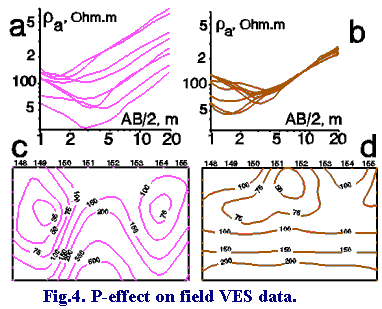 P-effect
was named from the word "potential". P-effect shows itself as a vertical
shift of VES curve along axis Rhoa without form changes, like
well known S-effect in MTS. The main cause of P-effect seems to consider
RhoMN at the location of NSI. If VES curve is non-segmented,
that P-effect may be found in comparison of this curve with the neighbors.
For segmented curve P-effect gives the shift of segments for different
MN with the total form of curve being conserved (fig.3). P-effect removing
is called normalization. For segmented curve it may be done firstly by
partial normalization (all segments are moved up to coming into contact
with each other) and then by fuller normalization (all VES curves on profile
are moved to the same base level of apparent resistivity). This base level
may be selected on the most unchangeable part of all curves (fig.4).
P-effect
was named from the word "potential". P-effect shows itself as a vertical
shift of VES curve along axis Rhoa without form changes, like
well known S-effect in MTS. The main cause of P-effect seems to consider
RhoMN at the location of NSI. If VES curve is non-segmented,
that P-effect may be found in comparison of this curve with the neighbors.
For segmented curve P-effect gives the shift of segments for different
MN with the total form of curve being conserved (fig.3). P-effect removing
is called normalization. For segmented curve it may be done firstly by
partial normalization (all segments are moved up to coming into contact
with each other) and then by fuller normalization (all VES curves on profile
are moved to the same base level of apparent resistivity). This base level
may be selected on the most unchangeable part of all curves (fig.4).
 On fig.4
are shown results of VES, measured in archaeological site "Krasnoe" near
"Kulikovo pole". As a result of P-effect, apparent resistivity pseudo-section
looks like wavered structure (fig.4,c). Step between VES sites in fig.4
is equal to 1 meter with maximal AO distance being equal to 20 m. That
means that differences between VES curves resulted from distortions, and
not from real deep structure. After moving all VES curves to one Rhoa
level (fig.4,b), apparent resistivity pseudo-section became horizontal
(fig.4,d) and interpretation gives horizontal boundaries.
On fig.4
are shown results of VES, measured in archaeological site "Krasnoe" near
"Kulikovo pole". As a result of P-effect, apparent resistivity pseudo-section
looks like wavered structure (fig.4,c). Step between VES sites in fig.4
is equal to 1 meter with maximal AO distance being equal to 20 m. That
means that differences between VES curves resulted from distortions, and
not from real deep structure. After moving all VES curves to one Rhoa
level (fig.4,b), apparent resistivity pseudo-section became horizontal
(fig.4,d) and interpretation gives horizontal boundaries.